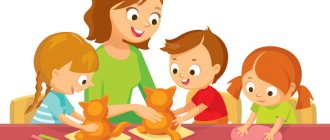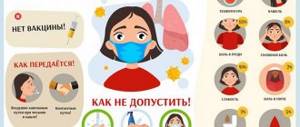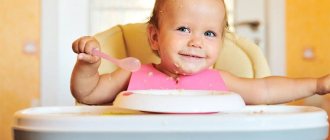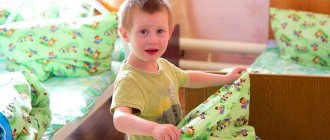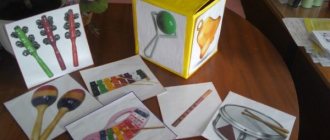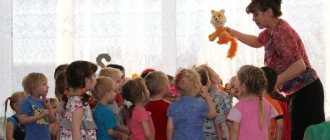Didactic game for children 4-6 years old: Table setting
Didactic game for preschool children “Table Setting”
This educational game is designed for children from 4 years old and allows you to reinforce the rules of table setting without the use of natural products and household items for table setting (dinnerware, tablecloths, etc.).
Recommended for playing at home. Integration: OO "PR, SKR, RR, FR, KHER" Goals and objectives: Develop methods of orientation in space using adverbs and prepositions (right, left, for, on);
improve communication skills in the process of interaction between an adult and a child, as well as with other children; to develop in children the ability to set a table and use tableware for their intended purpose; to form children’s ideas about the variety of species of homogeneous objects (spoons) - different in size, shape; consolidate knowledge of the definitions of large, medium (smaller), small (even smaller); develop speech, enrich the lexical vocabulary of children; consolidate knowledge about healthy and healthy food (HLS); develop fine motor skills of the hands; develop attention, memory, logical thinking. Progress of the game:
An adult gives the child a base-field (table) to play with.
And items for table setting, offering to set (set) the table for dinner.
The child completes the task, the adult asks questions about the rules of behavior at the table (ethics), about the rules of a healthy lifestyle and proper nutrition, about safety rules when using cutlery, reinforcing in children the ability to set the table and use cutlery for its intended purpose.
By asking the question “Where this or that spoon should lie,” methods of orientation in space are developed using adverbs and prepositions (right, left, behind, on). The game can be repeated several times, with the adult giving the child a base-field (table) to play with, 1 lightweight version
or 2 options for complication.
We recommend watching:
Musically-themed fairy tale for children of the middle group Didactic games with folk toys for children 4-6 years old Conversation with children of the older group on the topic “Culture of Behavior” Entertainment script about the rules of communication for children of the older group of kindergarten
Similar articles:
Scenario for a politeness holiday for preschoolers 5-6 years old in a preschool educational institution
Lesson “Polite words”. Senior group
Table behavior for preschool children
Game activities on the topic “Politeness” in the preparatory group of kindergarten
Games on the theme “Politeness” for preschool children 5-7 years old
Didactic games to develop cultural and hygienic skills
⇐ PreviousPage 3 of 4Next ⇒and culture of behavior:
· “Table, cover yourself!”
Goal: To strengthen the skills of setting a children's table.
Progress of the game: participants draw out leaves with images of dishes for different stages of nutrition (breakfast, lunch, afternoon snack, dinner) and set the tables using flat figures.
· “Find a place for the toy.”
Teach children how to properly place play materials and treat them with care.
Game tasks. 1. Play with toys (2-3 new toys) - recite a poem, ask a riddle, find out by description, etc. 2. Put toys in place. Evaluate together the correctness of the task: where is the best place for toys. The role of the leader can be played by the teacher or the child.
Equipment. Toys.
· "Rules of hygiene."
Using a counting rhyme, the driver is selected and leaves the group. The teacher and the children agree on who will portray what and what. Then the driver is invited, the children take turns demonstrating hygiene skills using gestures and facial expressions. The presenter must guess what the children are showing: washing, brushing teeth, wiping, combing their hair, bathing.
· "Good or bad?"
Goal: to develop the ability to behave correctly in society, to comply with cultural and hygienic standards; learn to assess the current situation, analyze the actions of others; develop the concept of cultural behavior.
The teacher shows children plot illustrations depicting various situations. For example, the picture shows how a child throws toys around, brushes his teeth, helps an elderly person climb the stairs, etc. Preschoolers should determine and justify the answer about which situation is positive and which is negative.
· "Feeding the doll."
Goal: to teach the simplest actions with story toys (feeding), to instill hygiene skills; cause speech activity; cultivate good feelings towards the doll.
· “Pick up a pair.”
Goal: to teach how to correlate objects with actions, to consolidate self-service skills.
How to play? Among the various images offered, kids should choose a logical pair. For example, clothes - closet, toothbrush - teeth, soap - hands, toys - toy basket, etc. In addition, children need to justify their choice.
· “Get started on lunch.”
Goal: to consolidate knowledge of the names and purposes of furniture and tableware for the dining room; teach how to properly and beautifully set the table, table manners; to form the basis of an attentive and caring attitude towards playing partners.
Equipment: doll, furniture, tableware, dinner tablecloth, tea tablecloth, table and tea napkins; an apron, a scarf, a pair of mittens - grips.
Children play with the doll independently. The teacher offers the children to feed the doll. The doll sits down at the table. But here’s the problem: there’s nothing to eat.
Children usually laugh. The doll is upset. We need to console her with the children: “Now we will set the table.”
It is necessary to prepare as many different dishes as possible in advance so that children can make the right choice and set the table for breakfast, lunch or dinner as they wish.
The doll is put on a headscarf and an apron and will help the children set the table. The teacher asks the children questions on behalf of the doll: “What should be put on the table first? What will we eat the second course and drink compote from?” Sometimes the doll makes a mistake, for example, it puts the cup on a plate rather than on the saucer. If the children themselves do not notice this, you need to attract their attention.
Finally, everything is ready: the nanny serves the doll food, and the teacher teaches her to sit at the table correctly, use cutlery, eat, and thank her for food.
The doll may ask: “Why do you need a spoon? It’s more convenient to eat with your hands, isn’t it, children?” And the teacher asks the children to tell the doll what they eat the first course, the second course, fruit from the compote. Then the doll asks: “What should you do after eating, children?” etc.
After the game is over, the children play independently, invite other dolls to visit, serve the tea table, etc.
Option. Pinocchio, Cheburashka, Khryusha, and other fairy-tale characters are invited to Malvina’s dinner. Children teach dolls to properly set the table, skillfully use cutlery, etc.
· “Clean crocodile.”
Purpose of the game: to develop self-care skills, reinforce the rules of personal hygiene; cultivate neatness and a thrifty attitude towards health.
The rules of the game are as follows: the leader (selected using a counting rhyme) shows with gestures and facial expressions any action related to the observance of hygiene rules, for example, brushing your teeth, washing your face, getting dressed, etc. The rest of the participants guess the action.
· “Let’s give the doll some tea.”
Purpose: to introduce the names of items from a tea set; practice proper table setting for tea drinking (sequence of arrangement of cutlery for tea drinking).
Equipment: tea set (saucers, cups, teapot, sugar bowl, dessert plates, cookie bowl), teaspoons.
Progress of the game.
The teacher turns to the children: “Guys, do you like it when guests come to you?” Today our favorite toys will come to visit us. Let's set the table for the guests. What will we treat them to? (Tea and cookies.)
The teacher explains to the children the sequence of arrangement of tea drinking utensils. First you need to place the bowl of cookies in the middle of the table.
Place saucers around the vase, and a cup on each saucer. A dessert plate should be placed next to each saucer. Each guest will put cookies on the dessert plate. Place a teaspoon to the right of each saucer. Place the sugar bowl and teapot last. They should also stand in the middle of the table so that each guest can conveniently take sugar and pour tea.
Then each child is given a short instruction such as: “Andrey, put the bowl of cookies in the middle of the table.” All children carry out assignments, placing tea utensils on the table. The teacher comments on their actions: “Andrey puts a vase of cookies on the table.” And so on.
Which vase is large or small? (The vase is large.)
After the table is set, the teacher summarizes the children’s statements.
Look, all that is on the table are dishes. Tea is drunk from this container. Such utensils are called “tea utensils”.
In conclusion, the children seat their favorite toys at the table and “treat” them to tea.
After the game, the teacher invites the children to help their mother set the table for evening tea in the evening.
· “Who can name more dishes?”
Goal: to develop speed of reaction to questions, attention; cultivate endurance and patience.
Progress of the game. The teacher names a vegetable or fruit and asks them to remember the dish that can be prepared from it. The one to whom the ball is thrown must name the dish without repeating itself. A child who makes a mistake or does not say anything misses the game. The teacher can set a dish, and the children must remember its components and agree on what component each of them will be. The host shouts out what he wants to put in the pan, and the one who recognizes himself jumps into the circle. The next one jumps up and takes the hand of the previous one. Until all the components are in the circle, the game continues. You can use mask caps, medallions with images of vegetables and fruits.
· “Etiquette is the school of graceful manners.”
Goals: teach the child table manners; tell what dishes and foods are eaten using cutlery; learn how to use cutlery.
Equipment:
subject pictures.
The ability to behave at the table and to handle cutlery correctly characterizes the level of education and cultural behavior of a person. Here are the rules to remember.
All soups and broths, porridges, as well as desserts (jam, ice cream, cake, compotes) are eaten with a spoon. The fork is used when eating salads, vegetable side dishes, scrambled eggs, pasta, dumplings, and meat products. A fork and a knife are needed when you eat foods and dishes that are difficult to separate with a fork: complex sandwiches, cheeses, sausages, pancakes, fish and meat dishes. You can take small sandwiches, pies, buns, grapes, cherries, cookies, and candies with your hands.
· “Let’s feed the animals salad.”
Goal: to consolidate the skill of proper eating - hold a spoon correctly (with three fingers - index, middle, thumb); cut plasticine vegetables with a plastic knife; use a large spoon to mix the salad in a bowl; feed the dolls salad.
Vocabulary: cucumber, tomato, onion; salad bowl, spoon; I hold, cut, mix, feed.
Equipment: toy animals; plasticine vegetables, plastic knife, fork.
How to play: bring a beautifully decorated box and invite the child to see what’s in it (toy animals). Say: “The animals came to visit you from the forest.
It's cold and hungry in the forest now. We should treat them with something.” Invite your child to make a vegetable salad and treat the animals.
Rhyme: I don't miss you today
I treat everyone to salad.
Animals sit on a stump
And they eat my salad.
The child must prepare a “salad”: cut plasticine vegetables; put them in a salad bowl;
Using a large spoon, stir the salad in a salad bowl in a circular motion; Place a large spoonful of salad on a plate for each guest; treat the animals with salad.
Thematic planning of conversations
in education
cultural and hygienic skills
and culture of behavior.
Preparatory group.
⇐ Previous3Next ⇒
Why do we need table rules?
Compliance with rules and etiquette at the table is not the prerogative of a certain social group of people. It has nothing to do with the level of income or social status of the family. “We are from simple people, from workers. Why do we need all these tablecloths, napkins, forks and knives? Why does my child need all this? “Kindergarten teachers sometimes hear something similar. It is important to understand that the culture of nutrition and behavior is not whims, not the desire to “show off” in front of others. The fact is that following certain rules of etiquette at the table makes sense and has specific benefits for children. Let's look at some of them:
- Washing your hands before eating protects the body from pathogenic bacteria entering with food;
- Setting the table using a clean tablecloth and disposable napkins protects food from coming into contact with the surface of the dining table;
- The requirement to “not fidget” and not talk while eating is to prevent serious incidents at the table (the child may choke);
- The request to “take your time,” sit up straight and chew your food thoroughly is nothing more than helping the stomach digest what you eat quickly and easily;
- A napkin placed on your knee (or chest) will protect your clothes from getting dirty.
Safe behavior of the child at home, in the apartment and in the entrance
I would especially like to highlight the use of special cutlery during meals. Many still believe that this is nothing more than deliberate behavior of the upper class, in order to show their skills and knowledge in this area. It's not like that at all. To use devices skillfully, you do not need to be a representative of a certain group. The use of devices is not intended to exhaust, but to facilitate the actions of the eater . It is much more convenient to eat meat by cutting it into pieces (rather than biting whole with a fork), it is convenient to cut fish with a special fork, and eat dessert with a small spoon or fork. It's true?
The lesson is a workshop. “Let’s teach Katya how to set the table for dinner.”
«Let’s teach Katya how to set the table for dinner.”
Target. Teach children to find similarities and differences in objects, to be able to group, combine objects according to similar essential features into one generic concept. Introduce the concept of “dishes”.
Tasks:
- Reinforce knowledge about different types of utensils and their purposes.
- Develop: finger motor skills, memory, perception, memory, thinking.
- Develop the ability to properly handle utensils.
- Develop the skill of consistently setting the table for dinner and clearing dishes after meals.
- Develop the ability to properly set the table for dinner.
Visual material. Doll, doll dishes, plates made of different materials - wood, glass, porcelain, plastic.
Progress of the lesson.
The teacher brings a smartly dressed doll to the group.
Educator: Look how smart Katya is. Do you know why? She has some guests coming to her house today, and she wants to treat them to something tasty. This box contains various items that Katya will need to feed her guests. Let's see what's in the box.
The teacher invites individual children to come to him in turn and take one item out of the box.
Educator: What did you get? What it is? (Castle.) What is it like? (Large, white.) What does the pan have? (Handles, lid.)
Educator: What did you get? What it is? (Plate.) What plate? (White, with flowers, round.) Is the plate deep or shallow? What is it for?
So the teacher examines all objects with the children, highlighting parts, shape, color.
Educator: That's how many items Katya has! What are they needed for? What is the saucepan for? What is a frying pan for? What about the plate? Etc.
Educator: We need all these items to prepare food or eat it. We cook soup in a saucepan and eat soup from a plate. Those items that we need to prepare food and then eat it can be called in one word - “dishes”. Repeat this word all together.
Educator: Irochka, how can you call a saucepan and a plate in one word? Educator: Seryozha, what is on my table? Name it in one word.
Educator: This is the kind of dishes Katya prepared to treat her guests. Let's help her set the table. The table is already covered with a tablecloth. Julia, what will you put on this table? (Plate.) And you, Pavlik? (So the children, together with the teacher, placing one object at a time and naming them, set the table.)
Educator: Now you can invite guests. We will put a vase with flowers, a napkin holder with napkins. Did we do it well? Take a close look at the table. It contains not only dishes, but also some other items that do not belong to dishes. Who guessed what these objects were?
If the children do not guess, the teacher examines some objects with them, asking leading questions.
Educator: Do you need a plate for food? (Yes.) And the cups? (Yes.) And the vase? (No.) So a vase is not a dish. What about the napkin holder? Do we eat from it? (No.) So, these are not dishes either.
Educator: Today we helped the doll Katya set the table and learned that the items that are needed to prepare food and then eat it can be called in one word - “dishes.”
Educator: Who can name the dishes that we don’t have on the table? (Children name various items of dishes, the teacher asks each time why the child decided that they were dishes.)
Educator: Dishes are made from different materials. The dishes from which we eat are made of clay and glass. It can break easily. Therefore, when you take dishes, put them on the table or remove them from the table, do it carefully so as not to break them. There are a lot of people who make dishes; it is difficult to make dishes, so you need to treat them with care.
Reinforcing the concept of “dishes”.
The teacher gives the children different pictures depicting utensils (except plates) and other items not related to utensils. He invites the children to bring him only those items that we can say are dishes. He also invites children to look at the pictures and say which utensils are missing. If the children find it difficult to answer, the teacher helps them remember what they eat soup or porridge from.
Didactic game “Festive table. Tea party."
Target. Strengthen children's ability to identify essential features and, on their basis, distinguish between similar objects: cup - glass, tablecloth - napkin, teaspoon and tablespoon.
Visual material. Doll; items on the teacher's table: two cups (larger for a child and smaller for a doll), a glass, a glass, a cloth napkin, a tablecloth, teaspoons and tablespoons.
Progress of the game.
Educator: Guys, the doll wants to drink tea. Let's help her. We have a table and a chair. What else will you need? Look at my table carefully. What would you, first of all, take to Katya’s table so that she can drink tea? (Cup, teaspoon, etc.)
Educator: This is all correct, but I think that the table should be covered with a tablecloth to make it beautiful. You agree with me? Irochka, take the tablecloth from my table and set the table.
Educator: What did you take? (Tablecloth.) How did you recognize the tablecloth? Why didn't you take this? (Shows a cloth napkin.) This is a napkin. What size is it? (Small.) Will she be able to cover the entire table? (No.)
Educator: What can we put on Katya’s table now? (Cups.) Volodya, go choose a cup for Katya. How did you know it was a cup? Why didn't you take a glass or glass? (Because the cup has a handle, but the glass and glass do not have handles.)
Educator: Guys, how many cups do we have? (Two.) Do you think Volodya chose the right cup for Katya? (Children's answers.)
Educator: Why, Volodya, did you choose a small cup? (Because it is for a doll and the other is for children, it is big for a doll.)
Educator: I still have spoons on the table. Nadya, choose a spoon for Katya. Why did you take a small spoon? (Because soup is eaten with a large spoon, but sugar can be stirred with a small spoon.)
Educator: So we have prepared everything for Katya to drink tea. And now you can play with it.
Table setting in a preschool educational institution. Table etiquette
Kochinova Natalya
Table setting in a preschool educational institution. Table etiquette
Relevance: This topic is relevant in the modern world, since the success of table setting is the final element before the actual serving of dishes, special attention should be paid to it.
Purpose of work: The main purpose of table setting is the neatness, convenience and attractive appearance of the table. Teach students how to set the table.
Purpose of serving: The purpose of serving is to create all the necessary amenities for guests during the meal, to help establish a good mood, to express attention and goodwill, to convey the semantic focus of thematic banquets and the establishment itself as a whole. Serving is a kind of art: table linen, dishes, flowers - everything should be harmoniously combined and form a single whole.
Objectives: To educate aesthetic taste, attentiveness, instill skills of work culture and accuracy, develop labor skills and performance skills. Develop an understanding of table setting rules
develop the desire and willingness to help parents around the house (set the table)
Planned results: children will gain knowledge and skills related to nutritional etiquette, which to a certain extent will affect the success of their social adaptation and establishing contacts with other people.
Equipment: textbook, workbook, tableware and kitchen utensils, posters. Students' homework is ready-made meals.
Introduction.
The professional duty of a kindergarten teacher is to teach the child table manners. This learning occurs both in specially organized classes and during meals.
Table setting should evoke in children not only a desire to eat, but also a desire to be neat, as well as lift their spirits and promote aesthetic development.
You can lay tablecloths on the tables, or an individual napkin under each cutlery.
The aesthetics of table decoration necessarily includes the presence of paper napkins, beautifully and correctly laid out cutlery (spoons, forks, knives, portioned sliced bread in a bread bin, cups (mugs) according to the number of children, a flower arrangement is allowed to decorate tables.
Etiquette.
Before eating, children wash themselves, tidy up their nose, hair, and clothes.
We teach children to sit at the table: the lower back should be pressed against the back of the chair, the soles of the feet should fully touch the floor, between serving dishes the right hand should be kept in the lap, and the wrist of the left hand on the table.
You MUST NOT sit with your legs crossed, swing on a chair, sit lounging, lean over the back of the person sitting next to you, push the chair away with all the weight of your body, drum your fingers on the table, or place your elbows on the table.
Table conversation.
Table conversation is required.
The topics of conversation should not affect the child’s personality, be edifying or exciting. Topics can be different, it is appropriate to talk about food, what it is made of, where these products were brought from, changing the topic is possible. It is important for the child to form his own opinion.
During table conversation, children must learn only two rules:
- do not engage in conversation until the speaker has finished,
- Do not speak while there is food in your mouth.
To be listened to is a child’s right, and it must be respected.
Teach the child to wish “bon appetit” and say “thank you” to all requests, addressing the junior teacher by name and patronymic.
How to use cutlery, napkins, and hold a cup.
Cutlery: knife in the right hand, fork in the left. We eat soup and dessert porridge with a tablespoon. At the end of the meal, the utensils are placed on a plate.
Use a paper napkin as needed, apply it to your lips, then squeeze it into a ball and place it on or next to a used plate.
A cup with a handle has the thumb on top of the handle, the index finger is inserted into the handle, supported by the middle finger, the rest are pressed against the palm.
Eat the rest of the soup by tilting the plate away from you. Leave the spoon in the plate;
Eat salads and vegetables (starting from the older group) with a knife and fork, help with the knife to pry up the food with the fork and hold it.
Porridge, omelet, tender soufflé can be eaten with a dessert spoon.
The second course, with or without a side dish, should be eaten with a knife and fork (starting with the older group).
Fruits are eaten in different ways. Adults should peel the fruit for children, but they are allowed to eat the whole apple.
Children spread butter on bread (loaf) themselves (starting with the older group).
Children eat buns and cookies holding them in their hands.
Soup with bread can be eaten by holding the bread in your left hand and biting directly from a piece.
Memo for junior teachers.
Cultural and hygienic skills. Work
Junior group
Formation of basic skills at the table: correctly use a tablespoon and teaspoons, fork, napkin; do not crumble bread, chew food with your mouth closed, do not talk with your mouth full, rinse your mouth after eating
In the second half of the year, the formation of skills: setting the table for dinner (laying out spoons, forks, arranging bread bins (without bread, plates, cups, etc.)
Middle group
Improving the skills of careful eating: take food little by little, chew it well, eat quietly, with a napkin.
Formation of the ability to independently perform the duties of a duty officer, the same as those acquired in the junior group.
Senior group
Improve food culture: the ability to correctly use cutlery (fork, knife, eat quietly, carefully, maintaining correct posture at the table; make requests, thank.
Forming a desire to conscientiously fulfill the duties of the dining room attendants: setting the table, putting it in order after eating
Preparatory group
Strengthening the ability to carefully use cutlery. Strengthening the ability to make requests and give thanks.
Developing the ability to conscientiously perform the duties of the dining room attendants: fully setting the tables and putting them in order after meals
Duty.
• Duties are introduced from the younger group, in the second half of the year, and set only one condition for the child: to help the junior teacher set the table.
• The child hands out spoons, puts out bread bins, glasses with napkins. The understanding of responsibility is not yet available to children under four years of age, and it would be wrong to put such a requirement before them.
• In guiding children, the teacher relies on their interest in the process of activity, creates an emotionally positive attitude towards it, explains the need to work hard and in every possible way encourages any attempt by the child to show independence.
• When leaving the table, the child can take his cup and take it to the serving table. The attendants clear the bread bins, glasses with napkins from the table, and the junior teacher clears the plates.
In the senior and pre-school groups, the attendants try to fully set the table. After eating, the attendants help the junior teacher clean up the dining tables.
• The attendants must have a special uniform: aprons and headgear (kerchiefs, caps).
